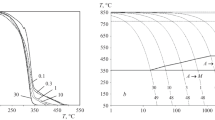Abstract
Structure and mechanical properties of rolled plates (20–35 mm thick) of low-carbon low-alloy steel subjected to thermomechanical treatment (TMT) according to various regimes under laboratory and industrial conditions have been studied. Structural factors that favor obtaining high mechanical properties have been established. The retarding action of TMT on softening upon tempering has been revealed. The reasons for the decrease in the resistance to brittle fracture of the steel subjected to TMT, repeated quenching from the temperature of the furnace heating, and tempering have been determined.
Similar content being viewed by others
References
L. V. Smirnov, E. N. Sokolkov, and V. D. Sadovskii, “Effect of plastic deformation in the austenitic state on the temper brittleness of structural alloy steels,” Dokl. Akad. Nauk SSSR 103, 239–257 (1955).
M. L. Bernshtein and M. A. Shtremel’, On the “hereditary” effect of cold-hardening on steel properties,” Fiz. Met. Metalloved. 15(1), 82–90 (1963).
L. Ya. Vinnikov, M. N. Pankova, and L. M. Utevskii, “Alternating interchange of misorientations on parallel subboundaries,” Fiz. Met. Metalloved. 31, 1018–1022 (1971).
A. G. Kozlova and L. M. Utevskii, “Structure of austenite and martensite of the 35SKhN12M steel formed as a result of hot deformation,” Fiz. Met. Metalloved. 38, 662–665 (1974).
M. L. Bernshtein, V. A. Zaimovskii, and L. M. Kaputkina, Thermomechanical Treatment of Steel (Metallurgiya, Moscow, 1983) [in Russian].
S. N. Petrova, V. D. Sadovskii, and E. N. Sokolkov, “Effect of thermomechanical treatment on the mechanical properties of the 35KhGSA steel,” in Strengthening of Steel (Metallurgizdat, Sverdlovsk, 1960), [in Russian], pp. 111–119.
E. N. Sokolkov and V. D. Sadovskii, “Effect of high-temperature thermomechanical treatment on impact endurance of structural alloy steels,” Fiz. Met. Metalloved. 18, 584–589 (1964).
A. B. Bukhvalov, L. V. Smirnov, and V. D. Sadovskii, “On the inheritance of strengthening upon thermomechanical treatment of steel, Ch. 1,” Fiz. Met. Metalloved. 27, 679–688 (1969).
A. B. Bukhvalov, L. V. Smirnov, and V. D. Sadovskii, “On the inheritance of strengthening upon thermomechanical treatment of steel, Ch. 2,” Fiz. Met. Metalloved. 28, 144–151 (1969).
M. A. Tylkin, V. I. Bol’shakov, and P. D. Odesskii, Structure and Properties of Constructional Steel (Metallurgiya, Moscow, 1983) [in Russian].
I. I. Novikov, Theory of Heat Treatment of Metals (Metallurgiya, Moscow, 1986) [in Russian].
F. B. Pickering, Physical Metallurgy and the Design of Steels (Applied Science, 1978; Metallurgiya, Moscow, 1982).
V. M. Schastlivtsev, T. I. Tabatchikova, I. L. Yakovleva, S. Yu. Klyueva, A. A. Kruglova, E. I. Khlusova, and V. V. Orlov, “Microstructure and properties of low-carbon weldable steel after thermomechanical strengthening,” Phys. Met. Metallogr. 113, 480–488 (2012).
V. M. Schastlivtsev, T. I. Tabatchikova, I. L. Yakovleva, S. Yu. Klyueva, A. A. Kruglova, E. I. Khlusova, and V. V. Orlov, “Effect of austenite-decomposition temperature on bainite morphology and properties of low-carbon steel after thermomechanical treatment,” Phys. Met. Metallogr. 114, 419–429 (2013).
M. A. Smirnov, M. M. Shteinberg, V. M. Schastlivtsev, V. I. Filatov, I. L. Yakovleva, and E. I. Patrakov, “Effect of high-temperature deformation on the structure and properties of isotermally quenched steel,” Fiz. Met. Metalloved. 48, 816–825 (1979).
A. A. Kruglova, V. V. Orlov, and E. I. Khlusova, “Effect of hot plastic deformation in the austenite interval on structure formation in low-alloyed low-carbon steel,” Metal Sci. Heat Treat. 49, 556–560 (2007).
Author information
Authors and Affiliations
Corresponding author
Additional information
Original Russian Text © V.M. Schastlivtsev, T.I. Tabatchikova, I.L. Yakovleva, S.Yu. Del’gado Reina, S.A. Golosienko, U.A. Pazilova, E.I. Khlusova, 2015, published in Fizika Metallov i Metallovedenie, 2015, Vol. 116, No. 2, pp. 199–209.
Rights and permissions
About this article
Cite this article
Schastlivtsev, V.M., Tabatchikova, T.I., Yakovleva, I.L. et al. Effect of thermomechanical treatment on the resistance of low-carbon low-alloy steel to brittle fracture. Phys. Metals Metallogr. 116, 189–199 (2015). https://doi.org/10.1134/S0031918X15020106
Received:
Accepted:
Published:
Issue Date:
DOI: https://doi.org/10.1134/S0031918X15020106




